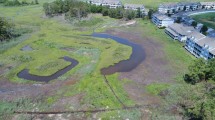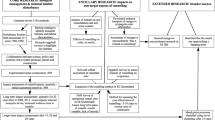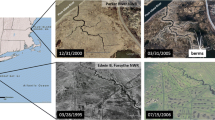Abstract
Open Marsh Water Management (OMWM) is a method for controlling salt-marsh mosquitoes using physical alterations of marsh habitat. Ponds and ditches are selectively excavated in order to create unsuitable environs for mosquito eggs and larvae while creating suitable habitat for larvivorous fishes. Based on environmental effects observed at two experimental sites, plus operational experiences in Delaware and adjacent states, guidelines are presented for designing and installing OMWM systems in Delaware. These guidelines should be applicable to other salt marshes from New England to Florida that have similar environmental characteristics.
The guidelines are intended to produce OMWM systems that will control mosquitoes while minimizing long-term ecological disruptions of the marsh community. They emphasize the following topics, including the environmental or economic reasons for why particular approaches were chosen: 1) use and location of open tidal ditches; 2) interspersion of open tidal ditches with closed, non-tidal ponds and pond radial ditches; 3) use of semi-tidal sill ditches and ponds; 4) incorporation of OMWM systems into previously parallel-grid-ditched marshes; 5) permissible lowering of the water table elevation in relation to local marsh surface, as caused by spoil deposition on the marsh surface and/or drainage from open tidal ditching, but not to such an extent that the original vegetation is replaced by other species during vegetative recovery; 6) protocols for designing, demarcating and installing OMWM systems; 7) density, depth and surface areas of ponds; 8) geometric vs. naturalistic excavations; 9) habitat enhancement for waterfowl use; 10) water quality, fish kills and dependable mosquito control; 11) OMWM alterations under special situations, such as upland border marshes with excessive freshwater runoff or marshes with intensive muskrat burrowing activity; 12) blending of OMWM with other marsh management goals.
Similar content being viewed by others
Literature Cited
Bruder, K. W. 1980. The establishment of unified Open Marsh Water Management standards in New Jersey. Proc. N. J. Mosq. Contr. Assoc. 67: 72–76.
Clarke, J. A., B. A. Harrington, T. Hruby, and F. E. Wasserman. 1984. The effect of ditching for mosquito control on salt marsh use, by birds in Rowley, Massachusetts. J. Field Ornithol. 55(2): 160–180.
Daiber, F. C. 1982. Animals of the Tidal marsh. Van Nostrand Reinhold Co. 422 pp.
Ferrigno, F. and D. M. Jobbins, 1968. Open Marsh Water Management. Proc. N. J. Mosq. Exterm. Assoc. 55: 104–115.
Ferrigno, F., P. Slavin, and D. M. Jobbins. 1975. Saltmarsh water management for mosquito control. Proc. N. J. Mosq. Exterm. Assoc. 62: 30–38.
Hansen, J. A., F. H. Lesser, R. W. Lombardi, J. K. Shisler, and P. Slavin. 1976. The economics of Open Marsh Water Management—a New Jersey view. Proc. N.J. Mosq. Exterm. Assoc. 63: 77–81.
Hruby, T. and W. G. Montgomery. in prep. Open Marsh Water Management— Manual of methods for Open Tidal Marshes in Massachusetts. Preliminary draft, April, 1984. 18 pp.
Lake, R. W. 1973. Biting flies of the Delaware salt marsh. Trans. Del. Acad. Sci. 70: 37–45.
Lesser, C. R. 1982. Standards for Maryland Open Marsh Water Management (OMWM). Proc. N. J. Mosq. Contr. Assoc. 70: 29–34.
Meredith, W. H., D. E. Saveikis, and C. J. Stachecki 1983. Delaware’s Open Marsh Water Management research program: an overview and update. Proc. N. J. Mosq. Contr. Assoc. 70: 42–47.
Meredith, W. H., D. E. Saveikis, and R. V. Cole. 1984. Effects of Open Marsh Water Management, a salt-marsh mosquito control technique, on bird populations of a tidal marsh. Trans. Northeast Fish Wildl. Conf. 1984: 78 (abstract).
Shisler, J. K., F. H. Lesser, and T. Candeletti. 1979. An approach to the evaluation of temporary versus permanent measures in salt marsh mosquito control. Mosquito News 39(4): 776–780.
Shisler, J. K. and T. L. Schulze. 1985. Methods for evaluation of costs associated with permanent and temporary control methods for salt marsh mosquito abatement. J. Amer. Mosq. Contr. Assoc. (Mosquito News) 1(2): 164–168.
Slate, D. 1978. A survey of salt ponds on a New Jersey tidal marsh. M.S. thesis. Rutgers Univ. 117 pp.
Author information
Authors and Affiliations
Rights and permissions
About this article
Cite this article
Meredith, W.H., Saveikis, D.E. & Stachecki, C.J. Guidelines for “Open Marsh Water Management” in Delaware’s salt marshes—Objectives, system designs, and installation procedures. Wetlands 5, 119–133 (1985). https://doi.org/10.1007/BF03160791
Issue Date:
DOI: https://doi.org/10.1007/BF03160791




